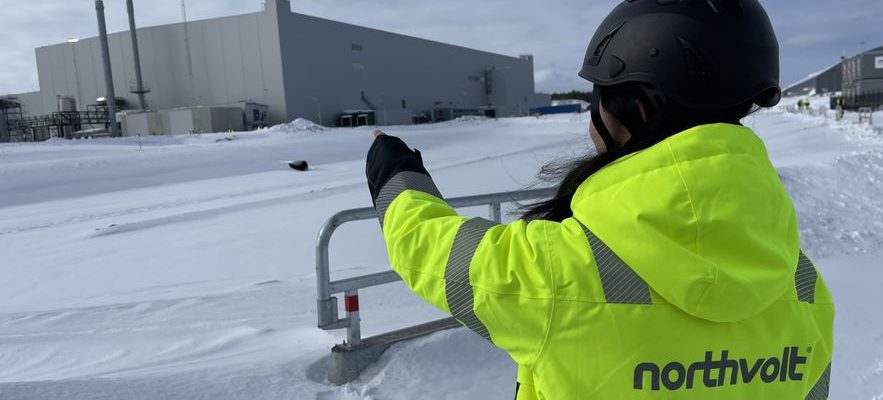What could be more detestable than a jet ski? Answer: a snowmobile. Noisy and 50 times more polluting than a car – but essential in snowy expanses until the end of April – the machine is an insult to nature. Luckily, young company Vidde Snow Mobility is changing the game. Next winter, its first quiet electric scooters will hit the Swedish market, with the country currently boasting 300,000 snowmobiles. “The economic potential is considerable”, explains the founder of the company, Christian Lystrup, interviewed just before a trip on a snow scooter.
“Each year, 125,000 machines are sold worldwide, including 25,000 in Scandinavia and the Alps, continues the CEO. However, you should know that in Sweden snowmobiles are responsible for 5 to 7% of CO2 emissions generated by all vehicle traffic”, adds the boss of Vidde Snow Mobility, which will produce 1,000 machines per year from 2024-2025. Nature lovers will then be able to silently explore the magical landscapes of the Arctic Circle by getting as close as possible to its majesty the moose.
The electric snowmobile is just one example of innovation among hundreds of others in northern Sweden which, in recent years, has decided to become the laboratory of ecological transition for the whole country, of Europe and the world. Transport, energy, mines, timber industry, architecture, tourism: the initiatives affect all sectors of this region, which was once in decline and is known for its mines, its hydroelectric dams (they provide 50% of Swedish electricity production) and its northern Lights. Thanks to a few megaprojects and hundreds of contractors, unemployment fell to 3.4%. Deserted by its youth fifteen years ago, the region, where 500,000 people live, is preparing to welcome 100,000 new inhabitants by 2040. Under demographic pressure, the price per square meter has soared.
Worldwide, steel accounts for 7% of C02 emissions
The prodigious mines of Kiruna which, from 1899, made the fortune of Sweden, and today provide 80% of European iron, were already exemplary in terms of environmental standards. Added to this today is the steel industry, which wants to be virtuous. A mega-investment split between the giants of ore (LKAB), steel (SSAB) and energy (Vattenfall) has enabled the creation of the company Hybrit, whose prototype factory is already producing ” green steel” made from green hydrogen instead of coal.
“As this highly polluting industry now accounts for 7% of global CO2 emissions, the development of this ‘clean steel’ is a turning point for the planet,” said Martin Pei, Vice President of SSAB. and initiator of Hybridit five years ago. Not far from there, the H2 Green Steel company, founded in 2020 in the garrison town of Boden, is developing a similar project which will also allow blast furnaces to be replaced by electric foundries. And reduce the carbon footprint by 95% compared to a traditional steel plant.
A very small part of the huge Northvolt battery factory
© / AG
Further south, the world’s largest onshore wind farm, Markbygden Wind Farm, is being built on a 50 by 20 kilometer rectangle. It will soon house 1,101 turbines. Finally, in Skelleftea, the regional capital, the recently built Northvolt mega-factory will eventually supply green electric batteries for one million vehicles, starting with Volvo, Volkswagen, BMW and Scania (trucks), partner brands of the project. . Founded by former Tesla employees, the company had 200 people three years ago, compared to a thousand today and 5,000 in three years, half from India, the United States, Japan and a hundred other nations.
“We are living through an unprecedented experience of societal transformation,” says Kristina Sundin Jonsson, who heads the city administration of Skelleftea, adapting to a pace of growth that is almost impossible to follow. The municipality, which had 72,000 inhabitants until recently, will have 90,000 in fifteen years. “We must simultaneously build housing, schools, infrastructure of all kinds; recruit 500 teachers in three years, but also doctors, nurses, masons, hoteliers”, she continues, seated in the lobby of the Wood Hotel, a recent 20-storey skyscraper built entirely of wood – and whose carbon footprint is lower than concrete buildings.

The first electric planes in service at Skelleftea will provide a regional taxi service
© / AG
Airport traffic has increased tenfold in ten years. Entirely carbon-free, the terminal is connected to the city by hydrogen buses. From the control tower (in wood), we see the first electric planes of 2 or 4 places take off. “Electric aviation will soon make it possible to inaugurate a local connection to Finland: economical, the journey will last only twenty-five minutes instead of the current seven hours by car”, assures the director of the airport Robert Lindgren, who also announces the imminent construction of a drone airport.
People come from all over to visit the Swedish “Arctic laboratory” which, in the land of reindeer, foreshadows the world of tomorrow. “Each week, we welcome delegations of journalists and elected officials from all over Europe; even the most jaded Stockholmers come to our house and exclaim: ‘Wow, things are happening here!'” explains Mayor Evelina Fahlesson.
The secret of northern Sweden? Its immense hydroelectric resources
But how did the Far North suddenly become attractive? Its secret is its natural resources. The immensity of its space is traversed by powerful rivers that feed an important network of hydroelectric dams capable of meeting the needs of economic investors. That’s not all. The social-democratic municipality of Skelleftea is also the only one not to have yielded to the sirens of privatization. On the contrary, it retained control of its hydroelectric company Skelleftea Kraft, but also of its electricity network, its port and its airport. Thanks to these assets, the town hall has beaten around fifty other European cities that dreamed of attracting the battery manufacturer Northvolt. “With us, decision-making is fast,” continues the director of services Kristina Sundin Jonsson, very business-oriented (she is a former KPMG).
However, challenges remain. First, you have to convince a skilled international labor force to settle in these icy latitudes, where the days last five hours in winter, without the sun rising above the horizon for weeks. “It is true that attracting whole families takes time,” admits Karin Degerfeldt, in charge of sustainable development at the town hall. This is why conferences and seminars extolling the merits of the Far North are organized in Stockholm, the United Kingdom or the Netherlands. Broadcast on a public channel, the reality show High tension, which focuses on the energy sector in northern Sweden, also promotes the region.
The other problem is electricity. While the region exports its current surplus to the south of the country, local production will not be enough to meet the needs of these new economic players. Worse still: the nuclear energy produced in the Swedish power stations in the South is not available for the needs of the North. In short, the equation is very complicated. But, intoxicated by the growth, the inhabitants of the Far North remain convinced that a solution will eventually be found. Confident and enthusiastic, with a broad smile on his face, Bo Wikström, who works in Skelleftea Town Marketing, summarizes: “We don’t have all the answers yet; we may not know exactly where we are going… but we let’s go!”
